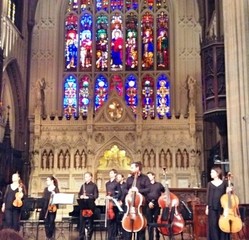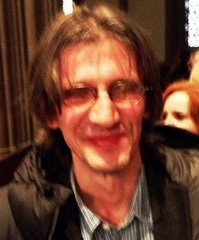|
Back
From the Kremlin to the Church New York
Trinity Church Wall Street, 75 Broadway
03/03/2016 -
“Revolutionaries: The Late Works of Beethoven and Ginastera” (1st Concert of 15)
John Corigliano: Voyage for string orchestra
Eskender Bekmambetov For Misha’s Gang: Suite for small, regular, large and extra large fiddles (World Premiere)
Alberto Ginastera: Concerto for Strings, Opus 33
Galina Yurchenko, Aleksandra Izenkova, Anna Tsypel, Evgeny Pravilov, Oskana Koliasnikova, Dina Semeniva, Olga Glomovzyk (Solo violins), Vladimir Morovsky, Artem Kopylov, Fedor Vetrov (Solo violas), Eliza Khanafina, Audrey Berezin, Alla Pitirimova (Solo cellos), Aleksander Pavlov (Solo double-bass)
Russian String Orchestra, (Formerly: Chamber Orchestra Kremlin), Misha Rachlevsky (Music Director/Conductor)

Russian Chamber Orchestra at Trinity Church (© Samuel A. Dog)
At the 45th minute of this one-hour concert–the first of 15 highlighting Ginastera and Beethoven–both Trinity Church and the Russian String Orchestra gave out equally heated flame radiation.
Over the pulpit of this Episcopal Church, sited new the southern end of Manhattan, are vitraux which are shatteringly beautiful, which neither glow nor radiate, but actually throw down bolts of lightening at the congregation. Seated in the pulpit was the visiting 18-piece Russian String Orchestra, which, after two works of varying quality, gave out mysterious but incandescent music for the final Concerto For Strings, by Alberto Ginastera.
Admittedly, I came here not for the music but for the original name of this quarter-century-old ensemble, “Chamber Orchestra Kremlin”. In Soviet and now Russian terms, that may have been an innocent title, a mere fortress. But while “Chamber Orchestra Kremlin” may be innocent in Russian terms, we Cold War veterans think the word Kremlin has the same frightening implications as Abu Ghraib or Seventh Circle of Hell. So their present new appellation, “Russian String Orchestra” is, while perhaps more marketable, less incendiary, less dangerous.
The group itself, with travels across the world, and rave reviews, certainly has some marvelous solo players, all of whom had time to impress this church congregation. Nor did they miss their opportunity to participate in Trinity Church’s most un-Episcopal series title: Revolutionaries.
Their 15 concerts, all at 1pm, celebrate two composers: Beethoven (a conscious rebel from the day he was born), and Alberto Ginastera, a truly original composer, but one for whom the word “revolutionary” hardly applies.
This concert began quite innocently with John Corigliano’s Voyage for String Orchestra. Alas, no program notes were distributed for these three unusual and picturesque works. So I didn’t know until much later that Mr. Corigliano’s piece was based on lines from a Baudelaire poem, that it was supposed to picture (in the composer’s words), “a drugged version of heaven full of sensual imagery. The music echoes the quality of the repeated refrain found in this lush translation: ‘There, there is nothing else but grace and measure, richness, calm and pleasure.’”
Knowing this might have augmented the listening experience. But hearing the strings doing music with the shifting harmonies of early 1970’s American music, made one inevitably think of the Barber Adagio. The latter is hardly sensual, but Mr. Corigliano’s work also, while very competent, is almost a student work of well-made chords and counterpoint. The playing, under the baton of the group’s founder, Misha Rashlevsky, was indeed more dreamy than urgent, but the players are superb.

E. Bekmambetov (© Samuel A. Dog)
The second work, a world premiere, was by Eskender Bekmambetov, the Uzbek-born 50-year-old who sometimes works as fiddler with the Russian String Orchestra.
The suite had not only an intriguing title but 10 intriguing subtitles–Introduction and Dance in Style of Art Nouveau, L’Elephant à la pointe, The 20th of February, 2014 etc. For each, two or three of the players would do solos with the orchestra, nearly all of them playful, several heavily ethnic.
Who would not have recognized the shetl rhythms of the Art Nouveau opener, played by two violas, one after the other? Or the Fiddle On The Roof offering from three lovely daughters...er, violinists in Canon For Three?
The most interesting, though, was the only morbid work, The 20th Of February 2014, the two descending half-tones played by Evegeny Pravilov. And what was this date? Mr. Bekmambetov told me this was the date when the Russian forces invaded the Ukraine through Crimea. I should have known.
Still, the most important work here was Ginastera’s String Concerto, new to this listener, and a revealing essay into mysteries and shadows. Like Mr. Bekmambetov’s work, the first movement gave a chance for solo strings to dominate, all with strange variations on a motive put out by the solo violin.
The following three movements were given “extreme” names by the composer. The “fantastic” Scherzo started with a mystery tremolo and went onto more fantasy. The “agonizing” Adagio reminded me of Bartók’s “night music”, as it sunk into a kind of musical nihilism.
Finally, the “furious” Finale, where Mr. Rachlevsky’s orchestra gave a brilliant showing of themselves, was Ginastera at his best. He had escaped the inevitable South American influence and proved (as he hopefully will prove over these months), one of the very original composers of our hemisphere.
Harry Rolnick
|